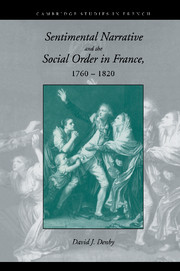Book contents
- Frontmatter
- Contents
- Acknowledgements
- Note on spelling
- Introduction: the politics of tears
- 1 Three sentimental writers
- 2 Towards a model of the sentimental text
- 3 Love and money: social hierarchy in the sentimental text
- 4 Sentimentalism in the rhetoric of the Revolution
- 5 Sentimentalism and idéologie
- 6 Beyond sentimentalism? Madame de Staël
- Conclusions
- Notes
- Bibliography
- Index
- CAMBRIDGE STUDIES IN FRENCH
2 - Towards a model of the sentimental text
Published online by Cambridge University Press: 29 August 2009
- Frontmatter
- Contents
- Acknowledgements
- Note on spelling
- Introduction: the politics of tears
- 1 Three sentimental writers
- 2 Towards a model of the sentimental text
- 3 Love and money: social hierarchy in the sentimental text
- 4 Sentimentalism in the rhetoric of the Revolution
- 5 Sentimentalism and idéologie
- 6 Beyond sentimentalism? Madame de Staël
- Conclusions
- Notes
- Bibliography
- Index
- CAMBRIDGE STUDIES IN FRENCH
Summary
In the preceding chapter I looked at some of the central preoccupations which emerge from the work of three minor sentimental authors. My purpose in the present chapter is to draw together these disparate strands, and to sketch out an interpretative model of sentimental narrative, a ‘meta-structure’ which exists nowhere in a textual form but which can be extrapolated from individual texts and can, on the model of the grammar, be understood as the set of rules which in turn makes possible the realisation of other texts. This attempt at synthesis will inevitably involve a consideration of some of the main aesthetic preoccupations of the period; here, l shall be drawing on much recent work on eighteenth-century aesthetics which, not surprisingly, takes as its focus the towering figure of Diderot. But a second concern will be to examine the place of sentimentalism within the overall culture of the period: I will suggest ways in which the textual patterns of sentimentalism reproduce the patterns of other types of text, and can therefore be said to belong to an overall process of cultural patterning called Enlightenment.
The preceding case-studies make it abundantly clear that the most fundamental category operating in the sentimental text is that of misfortune, malheur. Constantly overcome but constantly renewed in a multiplicity of forms (themselves analysable into patterns, as my third chapter seeks to show), misfortune is the founding event of the sentimental narrative, conferring on the person whom it befalls the crucial status of victim.
- Type
- Chapter
- Information
- Publisher: Cambridge University PressPrint publication year: 1994



